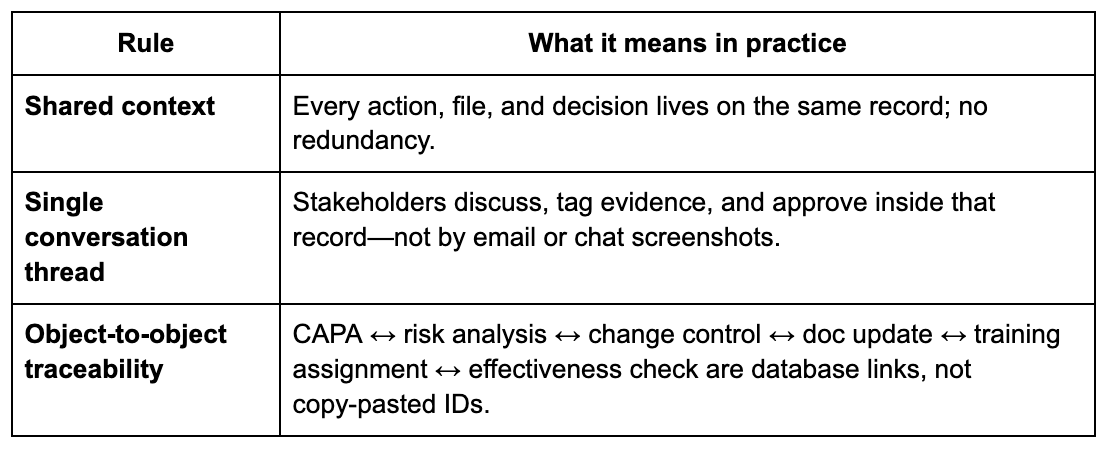The Problem: Modular QMS = Broken Loops
A field complaint lands on a Friday. By noon the team has opened a Root Cause Analysis record—owners assigned, urgency set, initial facts secured. By Tuesday the investigation points to calibration drift. By Thursday the associated CAPA, describing the required process tweak, is formally logged. And then—everything slows. Risk must be re-scored in its own spreadsheet. Change control moves through a separate queue in another tool. Documents are revised in a portal managed by the quality team responsible for implementing the CAPA, but invisible to investigators. Training waits for someone to notice the approval email. Two weeks later—at the verification-and-validation checkpoint before closure—the question is, “Did we fix it?” and the honest answer is, “We think so.”
Most QMS platforms connect CAPA, Risk, Change, Documents, and Training—but what’s missing is the traceable path between them. The individual systems function, but the context doesn’t follow through. Information is re-entered, context is re-explained, and decisions are approved without clear visibility into the evidence behind them. Audit trails may exist, yet the full story—how an event or non-conformance becomes a trained behavior—splinters across tools and owners. What’s lacking isn’t function—it’s real-time interconnectivity and cross-functional collaboration, the connective tissue that ultimately makes true traceability possible.. And without that, quality actions appear complete on paper, while the real gaps remain hidden.
Those fractures have a cost you can feel: cycle times stretch; “ineffective CAPA” reopens climb; training lags behind approved changes; audit prep devours hours stitching screenshots into cause-and-effect. Individual process dashboards look green while the organizational dashboard is red. A change closes on time, yet the people who run it every day aren’t trained, so the issue returns in a new form.
The fix isn’t another report. It’s treating quality as one connected conversation where every action, approval, document, and training record travels together—and proves the loop truly closed.
The Principle: Quality as a Connected Network
When a non-conformance is reported, seven obligations launch at the same moment:
- Triage and contain the issue.
- Investigate and document the root cause.
- Re-score risk in the FMEA or hazard file.
- Draft a change to process, design, or software.
- Revise controlled documents (SOPs, WIs, forms).
- Train everyone affected.
- Verify effectiveness and show regulators the proof.
These steps involve different people, systems, processes, and records, yet they describe one event. Treating them as separate “modules” forces teams to rebuild context at every hand-off.
A connected QMS applies three non-negotiable rules:

With these rules in place:
- Owners see downstream impact before they approve a change.
- Training tasks generate automatically when a dependent document reaches “approved.”
- An auditor can click one record and read the entire storyline from signal to trained workforce—timestamps, signatures, and evidence included.
Connected context turns quality from a relay race into a single, traceable thread—eliminating the seams where most failures occur.
The Story: From CAPA to Training in One Thread

Your Journey to Closing the Thread—With Unifize
Every organization’s path to a connected quality system is unique—but certain foundational steps make that journey more successful, no matter your starting point. Rather than trying to fix everything at once, the most effective approach is to build layer by layer, aligning your teams and systems around a shared source of truth.
Step 1: Centralize Your Documents
The foundation of any effective quality system is clean, organized documentation. Start by digitizing and importing your existing policies, SOPs, work instructions, and forms—whether they live in binders, spreadsheets, or shared drives..
Step 2: Define Training Needs from Your Docs
Once your documents are in place, use them to create and assign training requirements—based on roles, processes, or skills. Unifize lets you tie training directly to roles or skill sets—so when a document is approved or updated, the system automatically assigns the right training to the right people.
Step 3: Loop in your Quality Operations
Now bring in your quality ops—the stewards of your QMS. Let your quality team manage events like deviations and non-conformances inside Unifize. Instead of jumping across tools, they can capture context, assign tasks, and drive investigations all within one connected conversation.
Step 4: Bring in the Operational Teams
Once the quality team is comfortably using the system, the next step is to involve your operational teams—engineering, manufacturing, supply chain, or customer support. This is where quality stops being a back-office function and becomes part of daily operations.
For example, engineering can collaborate on change requests and provide design inputs during investigations, or manufacturing teams can be looped into CAPAs or deviations tied to inspections or production issues, or customer support can flag field complaints and stay updated as issues are investigated and resolved.
With a shared system, these teams don’t just receive quality outcomes—they help shape them, creating faster feedback loops and better decisions across the board.
Step 5: Extend Collaboration to External Stakeholders
When your internal teams are running smoothly, consider opening specific threads to your vendors, suppliers, or customers. With granular permissions, you can invite them into the process—whether it’s collaborating on a supplier issue or responding to a customer complaint.
Every company’s timeline will look different—but the goal is the same: to create a continuous quality loop that grows stronger over time. By layering capabilities in this way, you build a connected system where actions, evidence, and impact stay aligned—turning quality from a checklist into a shared conversation.
The Finish Line — One Thread, One Truth
Quality only wins when every promise you make to a regulator, a customer, or a teammate can be followed in a straight line—from the first signal all the way to trained people doing the new right thing. We’ve shown the problem (fractured modules), the principle (treat quality as a network), the story (how the work actually flows), and the journey (how we’ll switch you on). Together they draw a single conclusion:
When the work and the proof live on one conversation thread, closing the loop stops being a project and starts being business-as-usual.
Unifize exists to give you that thread—pre-configured, validated, and ready to pilot on real issues. If you’re ready to see your own CAPA turn into trained competence without the seams, let’s set the kickoff date.




